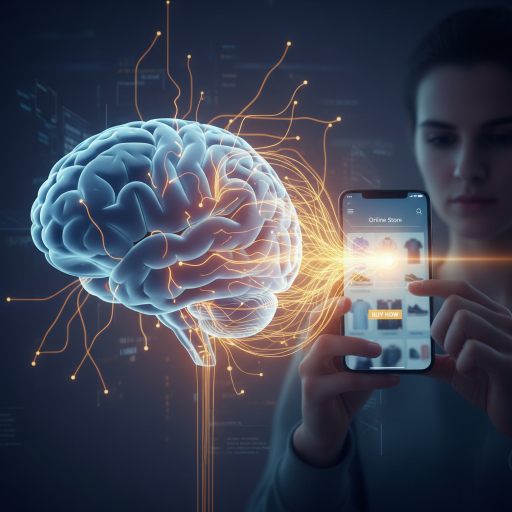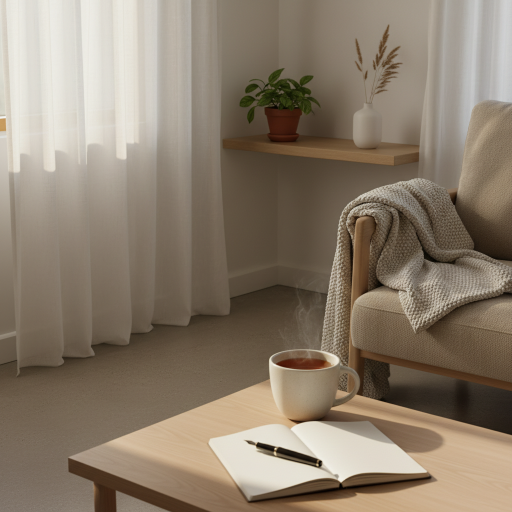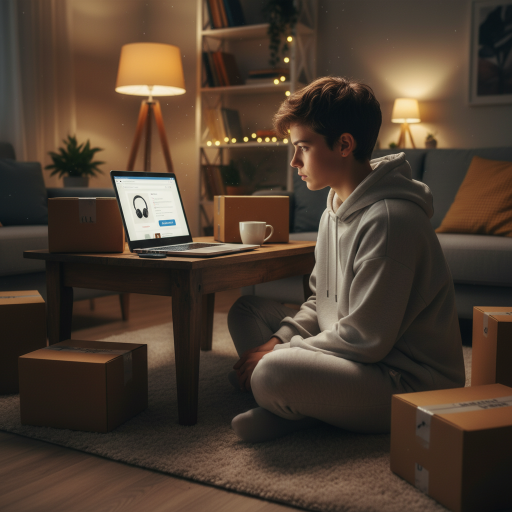Why We Buy What We Don’t Need
There was a time when I thought spending made me feel alive. Every new purchase, every “Add to Cart” click, every little parcel that arrived at my doorstep carried a temporary joy. It was as if I was trying to collect moments of happiness, sealed in cardboard boxes and wrapped in bubble sheets. I would tell myself that I deserved it, that after a hard day, a small reward was only fair. Yet, even before the excitement of unboxing faded, an emptiness would quietly return.
I began to notice a pattern that many of us share: the quiet cycle of wanting, buying, and regretting. It’s almost invisible until we pause long enough to watch ourselves in motion. For years, I thought I was just being normal, a participant in the ordinary rhythm of modern life. But slowly I began to see how deeply psychological this habit is. Spending, for me, was never really about money. It was about emotion, about what I was trying to fill, fix, or prove to my own self.
What is Emotional Spending?
“Emotional spending is the act of making purchases primarily to regulate a mood, such as buying something to alleviate boredom, stress, or anxiety, rather than to fulfill a practical need.”
The Hidden Emotions Behind Emotional Spending

I remember reading once that shopping gives our brain a small rush of dopamine: the same chemical that makes us feel pleasure when we eat something we love or hear our favorite song. It’s our brain’s way of saying, “Something good is happening.” But dopamine doesn’t last long. It spikes and then quickly drops, leaving us wanting more. That’s how impulsive buying quietly turns into a loop.
When I started paying attention, I realized that I often bought things when I was anxious, bored, and felt unconfident, not when I needed them. The purchase wasn’t about the product; it was about control. In moments when life felt uncertain, buying something gave me a sense of agency. It was a way to tell myself, “I can still choose, I can still make something happen.” That illusion of control soothed me, even if only for a while.
This pattern is deeply rooted in psychology. Our brain often links spending with self-soothing. It interprets the act of acquiring something new as a sign of progress, of moving forward. That’s why people sometimes call it “retail therapy.” But it’s not therapy at all. It’s more like emotional anesthesia. It numbs the discomfort, but it doesn’t heal what’s underneath.
The Mirror of Self-Worth
The deeper I went into understanding this, the more I realized how spending is tangled with self-worth. Many of us unconsciously equate what we buy with who we are. We wear brands like badges of identity. We collect possessions to fill gaps in our self-image. Somewhere in the back of our minds, a quiet voice whispers, “If I own better things, maybe I’ll be better too.”

Psychologists call this the symbolic self-completion theory: the idea that when we feel incomplete in some part of our identity, we use symbols (like clothes, cars, gadgets, or lifestyle products) to fill that void. It’s why someone who feels insecure about status might buy a luxury watch, or why someone feeling lonely might surround themselves with comforting but unnecessary items. We don’t buy the object; we buy the feeling attached to it.
I once read about an experiment where participants were made to feel uncertain about their personal traits. Afterward, they were more likely to choose products that symbolized those missing qualities. When people felt less powerful, they picked expensive brands. When they felt less attractive, they leaned toward beauty products. It’s fascinating, but also heartbreaking, how our insecurities drive the economy.
The Illusion of Abundance
We live in an age where we’re surrounded by abundance. Everything we could want is available with a few taps. But abundance can also create anxiety. The more choices we have, the harder it becomes to decide, and the more likely we are to make impulsive decisions. Psychologists call this decision fatigue: when our mental energy drains after too many small choices.
After hours of scrolling through apps or comparing prices, our willpower weakens. In that tired state, the brain starts seeking relief. That’s when we click “Buy Now,” not because we truly want something, but because we want the choosing to end. We spend to escape the mental noise of too many options.
I’ve noticed this in my own behavior. After long, draining days, I’d open shopping apps without intention: just to browse, to escape. I wasn’t looking for an item, I was looking for calm. And when I finally purchased something, the calm came, but only for a short while. Soon after, I felt a quiet unease, because deep down, I knew I hadn’t solved anything. I had only postponed a feeling.
That unease led me to a deeper question: what kind of abundance was I really surrounded by? Was it real, or just an illusion?

We often mistake availability for abundance. Just because something is accessible doesn’t mean it’s nourishing. The digital shelves are overflowing: thousands of products, endless options, infinite scroll. But this isn’t abundance in its truest form. It’s noise dressed as choice.
Real abundance feels quiet. It feels like clarity, like knowing what you need and trusting that it’s enough. Fake abundance, on the other hand, feels frantic. It’s the kind that floods your screen with “must-haves” and “limited-time deals,” convincing you that more is always better. It’s not abundance; it’s anxiety in disguise.
Psychologists talk about hedonic adaptation: the idea that we quickly return to a baseline level of happiness after acquiring something new. That shiny gadget, that trendy outfit, that impulsive splurge; they all lose their emotional charge faster than we expect. And so we chase again, mistaking the chase for fulfillment.
But real abundance doesn’t need chasing. It’s not about having everything. It’s about having what matters.
Purpose vs. Ego
I began to notice a subtle but profound difference in my spending habits. There were moments when I bought something that truly served a purpose: a tool that helped me create, a book that expanded my thinking, a gift that deepened a relationship. These purchases felt clean. They carried no guilt, no second-guessing. They aligned with my values.
But then there were the other purchases: the ones driven by ego. The ones I made to feel seen, to feel superior, to feel “caught up” with the world. These were the ones that left a residue. Not because the item was bad, but because the intention behind it was hollow.
Buying with purpose feels like nourishment. Buying with ego feels like decoration: temporary, fragile, and often performative.
There’s a psychological concept called self-congruity theory: it suggests that we’re happiest when our purchases align with our self-image. But the catch is, our self-image can be distorted. If we see ourselves as lacking, we’ll buy to compensate. If we see ourselves as whole, we’ll buy to enhance.
I started asking myself a simple question before every purchase: Is this for growth, or for validation? That question alone changed everything.
The Comfort of Belonging
Another powerful reason we spend is connection. We are social beings, wired to belong. From ancient tribes to modern social media, we’ve always needed to feel part of something larger. Today, brands have learned to speak the language of belonging. They no longer just sell products; they sell identities.
A sneaker brand doesn’t just sell shoes; it sells confidence and individuality. A smartphone company doesn’t just offer technology; it sells creativity, innovation, and community. We don’t just buy things; we buy into ideas of who we want to be and which tribe we want to belong to.
This is known as self-identity theory in psychology: the concept that our consumption choices help us define ourselves. The products we use signal our values, aspirations, and affiliations. But there’s a hidden cost. When identity becomes tied to spending, our sense of self becomes fragile. It starts depending on what we own rather than who we are.
I felt this when I once noticed how easily I could be influenced by what others had. If a friend upgraded his phone, I’d feel a quiet urge to do the same. Not because my old one didn’t work, but because I didn’t want to feel behind. It was subtle, almost invisible, but it was there: a silent fear of being left out.
The Emotional Void
At some point, I began asking myself a difficult question: “What am I really buying?”
When I stripped away the packaging and the reasons I gave myself: convenience, upgrade, reward; what remained was emotion. I wasn’t buying an object; I was buying comfort, validation, relief, or distraction. I was trying to fill an emotional void. And the truth is, we all have those voids.
Sometimes we spend to distract ourselves from loneliness. Sometimes it’s to quiet the fear of inadequacy. Sometimes it’s to recreate a sense of joy we’ve lost. But the problem is that the relief never lasts, because the void isn’t material; it’s emotional.

Psychologists often refer to this as emotional spending: using money as a way to regulate emotions. When we feel low, our brain craves quick dopamine boosts. Shopping provides one. But since it’s external and temporary, it doesn’t address the deeper cause. That’s why, after the initial thrill fades, the emptiness feels even louder.
It took me a long time to realize that emotional voids can’t be filled with things. They can only be filled with meaning: through connection, purpose, self-expression, or growth.
The Myth of Control and the Fear of Scarcity
Another layer beneath spending is fear: the fear of missing out, the fear of not having enough, the fear of falling behind. This is where marketing plays on one of our strongest psychological biases: loss aversion.
Research shows that people feel the pain of losing something about twice as strongly as the pleasure of gaining it. That’s why phrases like “Limited time offer” or “Only 2 left in stock” trigger instant urgency. Our brain hates the idea of missing out more than it loves the idea of gaining.
When I looked at my own buying habits, I realized how many of my purchases were driven by this very fear. The sale timer ticking down, the red “Only a few left” label; they created a false sense of scarcity. I wasn’t buying because I wanted the product. I was buying because I didn’t want to lose the chance.
Understanding this changed how I saw advertising. Once I recognized how easily my brain could be manipulated, I began to pause. I learned to step back and ask, “Would I still want this if it weren’t on sale?” That single question helped me make more mindful choices.
The Social Mirror
Our spending habits are also shaped by what we see around us. The human mind has something called social proof: we tend to copy what others are doing, especially when we’re unsure. When everyone seems to be buying something, it feels safe, even wise, to do the same.
Social media amplifies this effect. We see people living curated versions of their lives: perfect rooms, perfect vacations, perfect wardrobes. Without realizing it, we start comparing our everyday reality with someone else’s highlight reel. And comparison breeds dissatisfaction.
That dissatisfaction then turns into spending. We buy things to match the image we think we should have. But it’s a race without a finish line, because there will always be someone with more. The truth is, no one ever wins the comparison game. We just keep moving the goalpost farther.
The Path to Awareness
Breaking free from impulsive or emotional spending doesn’t happen overnight. For me, it began with awareness: not judgment, just observation. I started noticing how I felt before buying something. Was I stressed? Lonely? Bored? The answer was often yes.
When I began connecting my emotions to my spending patterns, I started to see the real story behind my purchases. I began to note down every feeling in my journal. Each time I bought something, I noted how I felt before and after. Over time, a pattern emerged. The things I bought out of emotion gave me a quick high but no lasting peace. The things I bought with intention stayed useful and quietly satisfying.
That small act of awareness slowly changed my relationship with money. I no longer saw it as a source of comfort or identity, but as a tool: something neutral, something that reflected my choices.
The Gentle Art of Restraint
Resisting impulsive spending isn’t about deprivation. It’s about learning the difference between desire and need. Our brain constantly sends signals of desire, but most of them are short-lived. Neuroscientists say that if you wait for ten minutes after feeling an impulse to buy, the intensity drops sharply. That’s because emotional impulses fade when they’re not acted upon.
So I began practicing small pauses. Whenever I wanted to buy something, I told myself to wait a day. Most of the time, the urge disappeared. If it stayed, I allowed myself to revisit the decision, but with clearer intention.
This practice taught me patience: not just with money, but with life itself. It reminded me that satisfaction grows slowly, like trust. You can’t rush it. And sometimes, what we call self-control is simply self-understanding.
Healing the Need to Buy

At the heart of this journey lies healing. We spend because we seek comfort, identity, and meaning. When we learn to meet those needs in healthier ways, the compulsion to spend naturally softens.
Instead of shopping to feel connected, I began spending more time with people who mattered. Instead of buying things to feel accomplished, I began investing my energy in learning and creating. Slowly, I started finding that same sense of satisfaction in things that didn’t cost anything.
Psychologically, this is about replacing external rewards with internal ones. When our brain learns to associate happiness with growth, creativity, or gratitude rather than material gain, the cycle of emotional spending weakens. It’s not about never buying anything again; it’s about buying from a place of peace, not emptiness.
The Deeper Lesson
As I look back, I realize that our spending habits are windows into our inner world. They reveal our fears, hopes, and unmet needs. Every purchase tells a small story: of what we thought would make us feel whole.
But real wholeness doesn’t come from what we own. It comes from what we understand about ourselves.
The more I observed my own patterns, the more I learned about the human mind. I saw how dopamine shapes desire, how loss aversion fuels urgency, how emotional voids seek comfort, and how identity hides in possessions. But beyond all that science, I saw something simple: a human heart, just trying to feel okay.
Finding Peace in Enough
Today, I still buy things. I still enjoy small luxuries and comforts. But now, I buy slowly. I ask myself why. I think about how it fits into my life, not just my day. And when I do buy, I try to do it with gratitude instead of impulse.
Because the real shift isn’t about spending less; it’s about feeling more. When we reconnect with our emotions, when we face what we were trying to avoid, the compulsion to fill the void fades on its own. We realize that “enough” isn’t a number. It’s a feeling.
In a world that constantly tells us we need more, learning to feel content with less becomes an act of quiet rebellion. It’s a way of reclaiming our peace from the noise of endless wanting.

The Calm Realization
I don’t think I’ll ever be completely free from desire. None of us are meant to be. Desire is part of being human: it drives us to grow, to explore, to dream. But I’ve learned to see it with softer eyes now.
When I feel the urge to buy something I don’t need, I pause and listen. I ask, “What are you really seeking right now?” Sometimes it’s rest, sometimes it’s connection, sometimes it’s just the need to feel seen. And when I tend to that need directly, the urge to spend fades, gently, like a wave receding back into the sea.
The psychology of spending isn’t just about money. It’s about understanding the quiet conversation between our emotions and our choices. It’s about seeing ourselves clearly, forgiving our impulsive moments, and learning to meet our needs with kindness instead of consumption.
We all buy things we don’t need sometimes. But with awareness, compassion, and a little patience, we can turn that pattern into understanding.
And in that understanding, we find something far more valuable than anything money can buy: peace with ourselves.
3 Ways to Interrupt the Emotional Spending Cycle
- The 24-Hour Rule: Wait a full day before purchasing any non-essential item. This allows the initial dopamine rush to fade, letting you make a decision from a place of reason, not impulse.
- Name the Emotion: Before you click “Add to Cart,” pause and ask: “What emotion am I trying to fix right now? Am I anxious, bored, or lonely?” Address the root emotion first (e.g., call a friend, take a walk).
- Review the Void: Journal about your purchases. Note how you felt before buying and how you feel two hours after the item arrives. Recognizing the fast drop-off in happiness weakens the purchasing loop.
A Gentle Note from MoneyHum
If these words found you in a moment of doubt or quiet exhaustion, take them as a small reminder that you are already moving in the right direction, even if it doesn’t always look like progress from the outside. Growth is rarely loud. It hides in your small acts of courage, your decision to rest, your willingness to keep learning when no one is watching.
At MoneyHum, we believe that real wealth is emotional as much as it is financial. It’s the freedom to slow down, to choose peace, to build a life that feels whole from the inside out. Our journey is to walk beside you as you create not just financial security, but emotional balance and clarity, a kind of abundance that lasts.
So before you close this page, take one deep breath. You’re doing better than you think. Keep learning. Keep growing gently. And remember, progress is still progress, even when it’s quiet.
If you’ve read this till the end, thank you❤️
With love,
Your Dearest Friend,
Chitraansh







